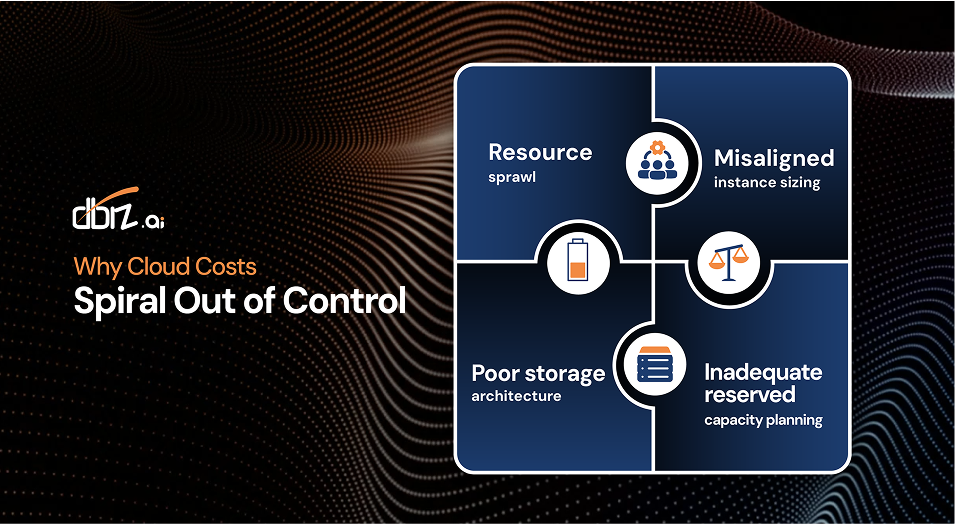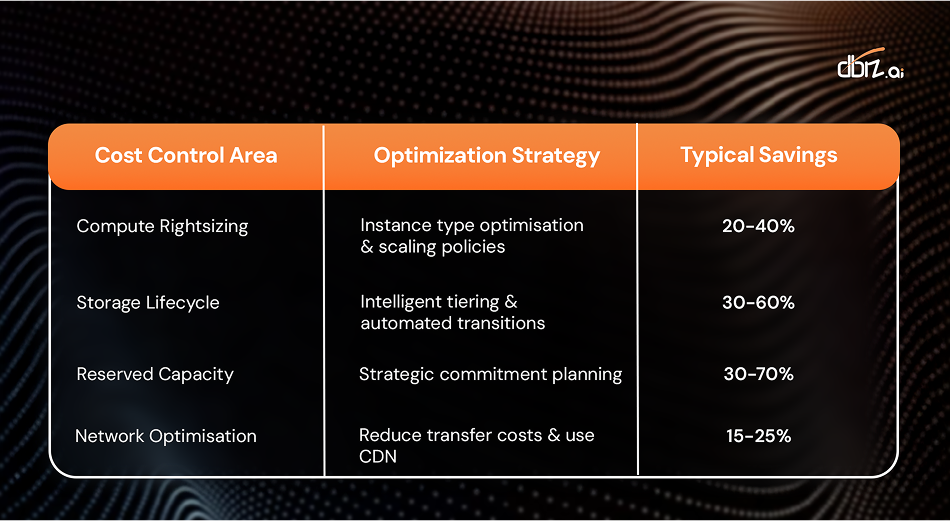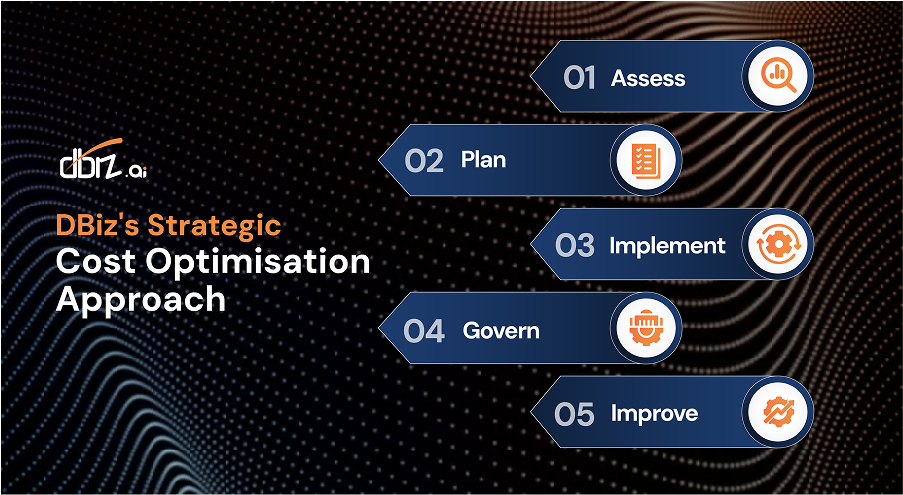Table of Contents
Introduction
Cloud costs often grow faster than the business value they create. You migrate to AWS expecting operational efficiency and agility, but monthly bills keep rising even as performance requirements increase. The challenge here is in architecting systems that balance cost and performance, delivering speed and efficiency in the same build.
Many organizations treat cost optimisation as a clean-up job that happens after the bill arrives, reviewing invoices only after the expense has happened. Smarter teams bake cost governance into architecture and use systematic optimisation to lower overhead while preserving scalability and reliability.
At DBiz, an AWS Advanced Tier Partner, we help teams in finance, real estate, logistics, and global SaaS firms reshape their AWS cost structures without giving up the capabilities that led them to the cloud. Here's how strategic cost optimisation works in practice.
Why Cloud Costs Spiral Out of Control

- Resource sprawl: When new projects spin up quickly, unused environments and old storage pile up. Without lifecycle policies, you end up paying for resources no one remembers or haven’t delivered business value in months.
- Misaligned instance sizing: Teams often size instance families and sizes to handle peak scenarios rather than average load. That leads to chronic over-provisioning and paying for idle capacity most of the time.
- Poor storage architecture: Storing infrequently accessed data in the wrong tier, or failing to automate transitions, creates recurring costs. Storage decisions should reflect access patterns and retention requirements; otherwise, monthly bills keep growing for data that rarely gets used.
- Inadequate reserved capacity planning: Ignoring Reserved Instances or failing to choose the right Savings Plan can cost more than running on-demand when workloads shift. Conversely, missing predictable commitments means foregoing substantial discounts.
Strategic Cost Governance Framework

Effective cost optimisation requires systematic approaches that embed cost awareness into architectural decisions rather than treating it as an afterthought.
- Resource tagging and cost visibility: A consistent tagging model gives you granular visibility across teams, projects, and products. Chargeback or showback models follow naturally, and accountability changes behavior quickly.
- Automated lifecycle management: Policies that automatically archive, transition, or delete unused resources cut operational overhead. Automating these clean-ups can save hours and thousands each month.
- Performance-based rightsizing: Use CPU, memory, I/O, and network data to match resources to real needs. Rightsizing can maintain or improve performance while lowering costs when decisions are driven by observed utilisation rather than assumptions. Done well this will improves performance and cuts costs.
- Architectural efficiency reviews: Periodic design reviews reveal opportunities across service selection, data flow, and integration patterns. Small design changes can unlock major savings.
Core Technologies for Cost Control
AWS provides the building blocks; the value comes through how you apply them.
AWS Cost Explorer and Cost and Usage Reports (CUR) reveal spending trends and enable detailed allocation.
AWS Budgets provides alerts before costs cross threshold.
Compute Optimiser and Trusted Advisor suggests rightsizing and configuration improvements.
Savings Plans, Reserved Instances, and Spot Instances offers options for balancing price and flexibility. Spot is cost-effective for batch and fault-tolerant workloads; Savings Plans work well when usage patterns are stable.
Instance Scheduler and Auto Scaling automatically match capacity to real time demand.
S3 Intelligent-Tiering and Glacier manage storage cost by automating data movement according to access patterns.
CloudWatch powers monitoring and alerting; Links performance metrics with cost visibility.
Third-party FinOps platforms can add value when you need business-facing dashboards, anomaly detection, or multi-cloud correlation. DBiz evaluates tooling choices against client needs rather than selecting platforms by default.
Architectural Strategies for Sustainable Optimisation
- Multi-Layered Cost Controls integrate cost awareness into every aspect of cloud architecture. This includes resource selection based on performance requirements and cost efficiency, automated scaling policies that respond to actual demand, and lifecycle management that prevents resource accumulation over time.
- Performance-Cost Balance ensures optimisation efforts enhance rather than compromise system capabilities. Strategic instance selection, intelligent caching, and efficient data processing patterns often improve performance while reducing costs through better resource utilization.
- Continuous Optimisation Processes maintain cost efficiency as business requirements evolve. Regular architectural reviews, automated recommendations implementation, and performance monitoring ensure cost optimisation remains effective as workloads change and grow. Optimisation is an ongoing habit, not a one-off project.
DBiz's Strategic Cost Optimisation Approach

Our AWS-certified team pairs technical depth with business context. Rather than submitting one-off reports, we build governance and operational practices that stick.
Assess: Review usage, cost drivers, and architecture to identify quick wins.
Plan: Prioritise actions that align with your product roadmap and financial objectives.
Implement: Apply rightsizing, tagging, scheduling, and buying strategies with minimal disruption.
Govern: Establish dashboards, alerts, and ownership models so savings persist.
Improve: Keep optimisation continuous with automated recommendations and periodic architecture reviews.
This approach has served our global clients well because it factors in regional pricing differences, compliance constraints, and growth scenarios. We adapt playbooks to match seasonal demand cycles, regulated environments, and multi-region deployments. The outcome is predictable savings without compromising capability.
Sustainable Cost Management for Growth
Strategic AWS optimisation gives you budget flexibility to invest in product features or new markets. The best programs balance immediate cash savings with long-term architectural sustainability. That means understanding trade-offs: what shorter-term commitments buy you in savings, and how those commitments interact with planned growth.
Once cost management becomes part of everyday engineering and finance conversations, it stops being a fire drill. It becomes a way to make smarter investment decisions.
The right time to make AWS work harder for your business is before the next bill arrives.
DBiz can show you how, with an assessment, action plan, and a governance model designed to keep your environment lean and high-performing.


